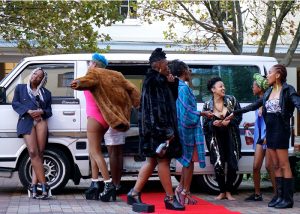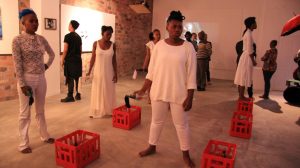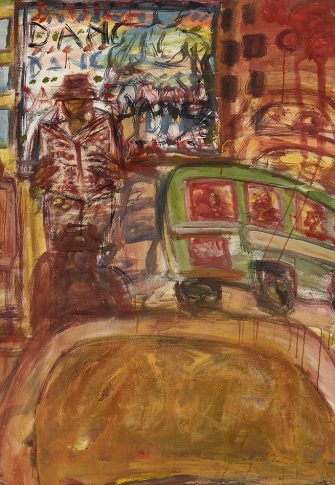What better way to counteract centuries of art that idealised and demonised women and their bodies, than to be confronted by real women in all their corporeal glory? There lies the attraction of performance art for over half a century’s worth of feminists. The art collective iQhiya harnesses the power of performance to confront the art world with their identities as young, black, female artists. Asemahle Ntlonti, Bronwyn Katz, Buhlebezwe Siwani, Bonolo Kavula, Charity Matlhogonolo Kelapile, Lungiswa Gqunta, Pinky Mayeng, Sethembile Msezane, Sisipho Ngodwana, Thandiwe Msebenzi, and Thuli Gamedze have created and written about art individually, but have gained attention by working together. They addressed this in a recent interview, stating that, ‘Working as a unit has given us more exposure. We laugh at the fact that our homogeneous status is far more appealing than our own individual endeavors.’
For many, the memory of the Rhodes statue finally being lifted away from its place at the centre of the University of Cape Town is dominated by the image of Msezane, beaded and winged, performing what she described to The Guardian as a depiction of “the statue of the Zimbabwe bird that was wrongfully appropriated from Great Zimbabwe by the British colonialist Cecil Rhodes”. Siwani, elaborately dressed and gestural, is conjured in many minds when thinking about the present state of performance art in Cape Town, through her interventions in major galleries. Gamedze, in conjunction with her artistic practice, has written reviews that challenge galleries and their façade of unassailability with post-colonial, feminist readings. These are a few of the many artistic successes achieved by iQhiya’s members individually, though each artist’s practice is deserving of an article of its own. And yet, there is something especially ‘appealing’ about their work as a group.
Years ago, I read a list of rules for writers by Zadie Smith. I have only ever remembered the sixth rule: ‘Avoid cliques, gangs, groups. The presence of a crowd won’t make your writing any better than it is.’ But witnessing iQhiya’s rise in the Cape Town art world’s consciousness has evoked another memory. Like many black mothers, my mother was part of group of women who got together one Sunday a month for their stokvel. It was not about the money they raised, and though it was about the party, what was significant was the support that this group offered. They were each well-educated and hard-working, making inroads in industries that had only recently and reluctantly made space for black women. In the moments when they felt discounted and held back by the structures involved in their individual professions, they were able to rely on each other, and to challenge each other’s preconceived notions. iQhiya seems to share these qualities.
Perhaps because they each have their own artistic practices, their performances haven’t fallen into the trap that Zadie Smith warned against, of using the group to hide individual weaknesses. Rather, they have used their numbers to their aesthetic and conceptual advantage. In their performance Commute Part II (2016), they staged a party, complete with a red carpet, mini skirts, swimsuits, heels, sparkling wine and Beyonce, out of a minibus taxi. The performance simultaneously spoke to the shunting of black people to Cape Town’s peripheries, and celebratorily flouted the policing of women’s bodies and the calls for modesty used to justify the brutalising of women on public transport. Commute Part II reminded me of the words of Lucy Lippard,
Because women are considered sex objects, it is taken for granted that any woman who presents her nude body in public is doing so because she thinks she is beautiful. She is a narcissist, and Acconci, with his less romantic image and pimply back, is an artist.
And while it is still possible to be dismissive of Commute Part II, the sheer fact that it is not one woman but eleven resists such a reading. It gives their art the credence of a movement because they act not only for themselves but, at the very least, for each other.
iQhiya’s first performance, Portrait (2016), presented as part of #theopening curated by Justin Davy at Greatmore Studios was inspired by a black-and-white photographic portrait of Gqunta’s mother and aunts in their twenties. Portrait was a depiction of the strength and struggle of black women. They stood on the top of glass coke bottles in crates, using their real pain to evoke the pain of living within a system that objectifies them. They also stuffed doeks into glass bottles, reminiscent of the gasoline-soaked rags in Molotov cocktails, serving as a reminder of the role black women have played in resistance movements.
This image, a silent, non-violent reflection of the tactics used against oppressive governments in South Africa and elsewhere, highlights the inherent significance of marginalised people joining forces to fight for their interests, the inherent significance of iQhiya.









